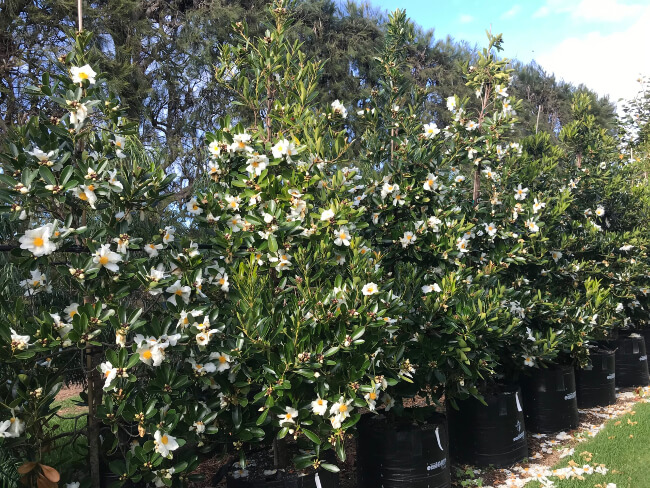Do you have enough space and want to have an exotic, tropical addition to your home garden? If so, you should think about planting a gordonia aka fried egg plant tree.
The gordonia originates from Southeast Asia in China and Vietnam. These small trees, dubbed the “fried egg” plant because of their distinctive white and yellow flowers, will make an exceptional addition to your property.
More...
Gordonia Fried Egg Plant Size
The gordonia is a small tree, ranging in size from 2.5 – 6m (8-20ft) tall and is a relative of the Camellia. The gordonia has waxy green leaves whose tips turn vibrant red in the winter.
Fried Egg Plant Flowers
The most striking feature of the gordonia is its large white flowers with a yellow centre that have led to it being referred to as the “fried egg” or “poached egg” tree. The flowers grow up to 4 inches wide and fall to the ground, leaving a carpet of flowers in their wake.
Some may find this to be a negative, but the sight of fallen flowers on the ground can be quite visually stunning in a home garden, especially since the gordonia sheds its flowers with the yellow stamen side up.
The gordonia has a relatively long flowering period between spring and autumn, with peak flowering occurring in May to June. The gordonia is a hardy tree that resists pests and disease.

Source: Tauranga Tree Co
Ideal Conditions for Growing Fried Egg Plant
A gordonia prefers direct sunlight, but can tolerate slight shade and can withstand temperatures ranging from hot to slightly below freezing. The tree is slow growing, so it may take time to take shape.
Gordonia are perfect additions to a garden that will provide a striking centrepiece along a walkway or trail. Be sure to position the tree so that the flowers will drop near the trail, allowing garden visitors to admire the beautiful blossoms.
Since the gordonia can grow more than 6m (20ft) tall, it also makes for a perfect, natural barrier, shielding spots in your garden from direct light and adding to your privacy.
Caring for Gordiana
A gordiana requires little maintenance. All that it needs is a light pruning and fertilising in the spring before it starts blooming. Next time you’re looking for an attractive tree for your garden, consider purchasing a gordonia.
Fried Egg Plant Frequently Asked Questions
What is the best soil for Gordonia fried egg plant trees?
Fried egg plant trees, or Gordonia, like slightly acidic and well-drained soil, but like plenty of moisture, so it can be tricky to find them exactly the right spot. They are quite deep and wide rooted though, so will generally find the moisture they need.
Can you grow gordonia in pots?


Get Your Free Guide:
Master Growing Australian Natives eBook
A Must Have Complete Guide for Every Australian Garden
Get Your Free Guide:
Master Growing Australian Natives eBook
A Must Have Complete Guide for Every Australian Garden
Gordonia do best when planted in the ground but can do well in large pots. Choose large terracotta pots for planting directly into as they will need plenty of root space.
What is the natural habitat of Gordonia, the fried egg plant tree?
Gordonia fried egg plant trees are native to Southeast Asia, where they grow predominantly on hillsides, with high rains but fast drainage. They grow best in similar situations and with plenty of direct light.
How fast does the fried egg plant tree grow?
Fried egg plants are slow growing trees, generally growing less than 1 ft per year. Once established they can put on new growth quite quickly, but they take a while to mature in gardens so it’s worth buying a semi-mature tree for quick impact.
What is the proper name for Gordonia, the fried egg plant?
Gordonia is a genus of plants in its own right, commonly referred to as fried egg plants, or fried egg trees. Some species have been reclassified into the Polyspora genus.
Why is my fried egg plant dying?
The most common problem when growing fried egg plants is waterlogging. If the soil becomes overly damp for a prolonged time they can drop leaves, or become evenly yellow. They do usually recover, but try to improve drainage when you spot signs of ill health on any Gordonia.
Does Gordonia have invasive roots?
Gordonia roots are not invasive. They have fairly large root spreads, but do not damage property, and will rarely trouble surrounding plants.
What is the fried egg plant tree used for?
Gordonia trees are used in landscaping as decorative shade. Their vibrant flowers offer seasonal interest, and their reliably evergreen foliage offers year-round shade.
When does the fried egg plant tree flower?
Fried egg plants flower between early autumn and mid-spring. Their long flowering season makes them ideal for gardens with difficult winter conditions where they add colour through the dullest of months.
Is the fried egg plant tree safe for pets?
Fried egg plants are not known to be specifically toxic but, like any non-food plants, over-ingestion can cause severe gastrointestinal upset.
Is Gordonia drought tolerant?
Gordonia might require good-drainage but it is not drought tolerant. It requires regular irrigation and protection from the hot summer sun where possible.
How do you care for gordonia fried egg trees in winter?
Gordonia is frost hardy, so doesn’t need any general winter protection. It does not, however, like windy spots, so cold winter winds should be protected against, either with protective planting or by planting near walls to limit the prevailing winds.
Bring Charm to your Garden with the Delightful Fried Egg Plant
With its beautiful flowers and low maintenance requirements, the gordonia fried egg plant tree will serve as a visual anchor point in your garden for years to come.
Published on October 20, 2023 by Maisie Blevins
Last Updated on November 21, 2025




